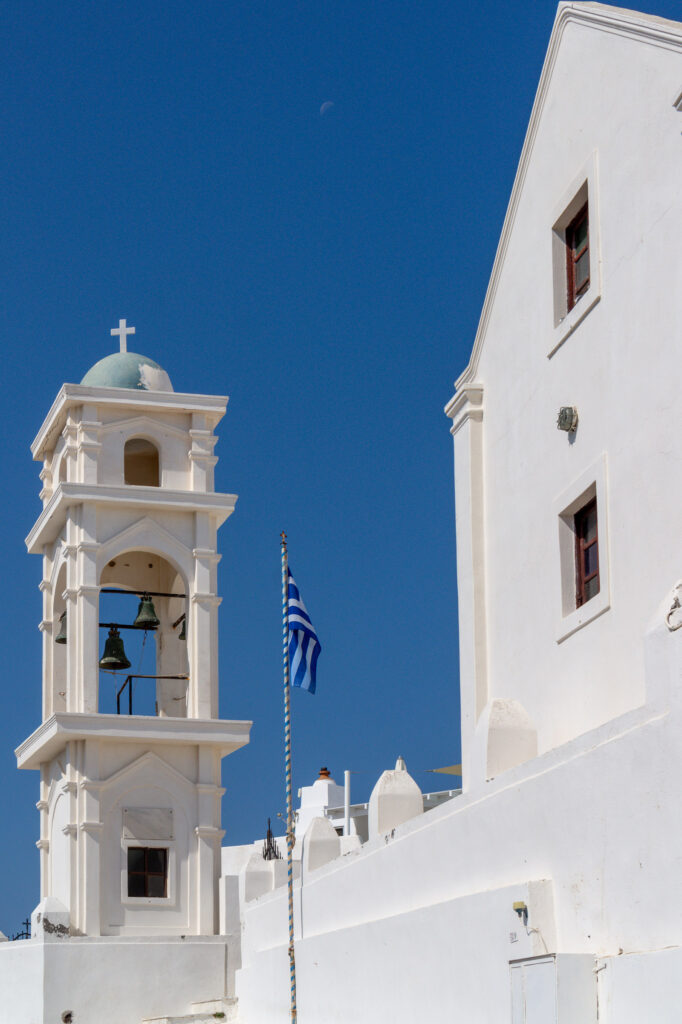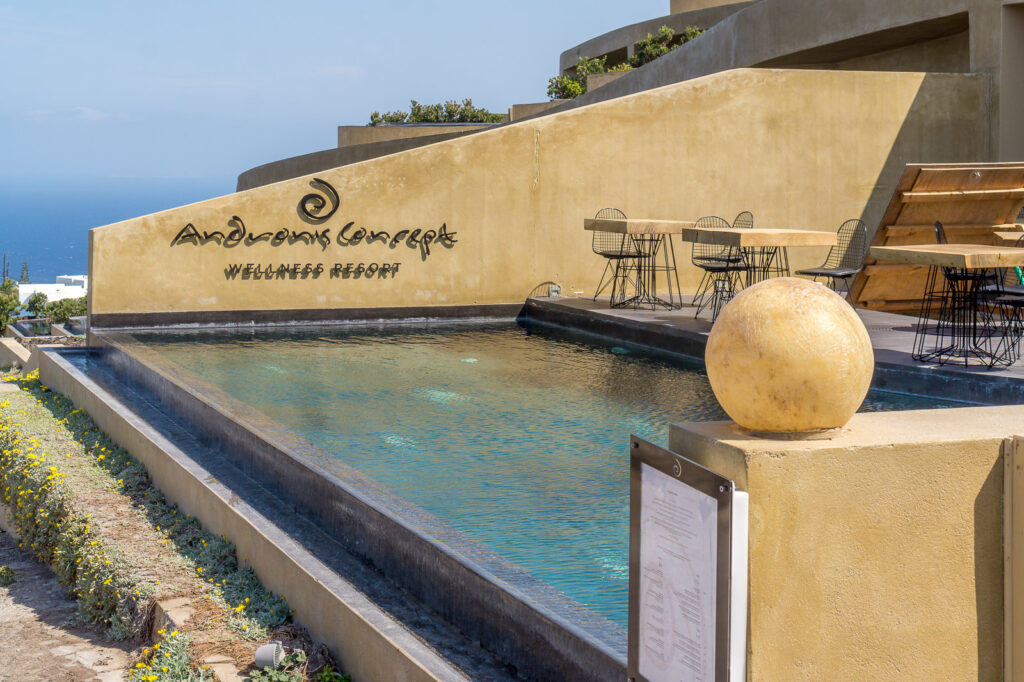Last Updated on: 17th November 2025, 09:17 am
Thinking about visiting Santorini in March? You’re considering one of Greece’s most enchanting islands during its quietest season.
While March won’t give you the picture-perfect beach weather that summer brings, it offers something equally valuable: a fulfilling experience without the overwhelming crowds.

Here are answers to the most common questions travelers have about visiting Santorini in March.
What is the weather like in Santorini in March?
March marks the transition from winter to spring in Santorini, with average daytime temperatures ranging from 14°C to 17°C (57°F to 63°F), while evenings cool down to around 10°C (50°F). The weather can be quite unpredictable during this month.
Early March can still feel extremely wintery with heavy showers, but conditions generally improve as the month progresses, with temperatures increasing and this being the last month of significant rainfall until October. You’ll enjoy around six hours of daily sunshine, the most Santorini has seen since October. If you missed visiting Santorini in October, consider booking your trip for March or April.

The key to enjoying March in Santorini is flexibility. Pack layers including light sweaters and jackets for cooler evenings, but also bring sunglasses and sunscreen for those beautiful sunny days. Don’t forget rain gear or an umbrella, as occasional showers are still possible.
On a more personal note, I’ve noticed something I’d call a seasons shift. Winters are warmer than they used to be 20 years ago, while springs tend to be cooler and wetter. I’d keep tabs on weather forecasts and make my travel arrangements on a fairly short notice, in order to minimize the risk of spending time indoors on a stormy island.
Can you swim in Santorini in March?
The sea temperature in March averages around 16-17°C (60-63°F), which is quite cold for swimming. For most people, this temperature is not enjoyable. I wouldn’t try to swim. Swimming in cold waters is not my favorite thing to do.
That said, if you’re feeling adventurous and accustomed to cold water, it’s technically possible with a wetsuit.
Many visitors find it more appealing to enjoy the beaches for walking and photography rather than swimming. The good news? Many hotels feature heated pools and spa areas, so you can still enjoy a relaxing dip during your stay.
Will most things be closed in Santorini in March?
Yes.
March falls at the tail end of Santorini’s low season, meaning many hotels and restaurants have yet to reopen to the public. This is perhaps the biggest consideration when planning a March visit. Furthermore, many property owners would renovate and repair their properties for the season to come. This usually involves lots of drilling and other such noisy works.
Your best strategy is to base yourself in Fira, the island’s capital, which remains lively year-round with more establishments open. Besides, the main bus station on the island is in Fira. This is the main public transportation node in Santorini.
By starting your journeys in Fira, you’ll be able to save a lot of time, as you won’t need to change buses to get to remote villages.

Oia is another solid choice, though it’s noticeably quieter than Fira during this time.
Beach resorts like Kamari and Perissa typically don’t fully awaken until mid-April, so you’d be better off simply visiting them without staying overnight..
The upside? March’s tranquil ambiance and fewer crowds offer a unique chance to experience Santorini’s beauty without the usual crowds.
Is March a good time to visit Santorini?
This depends entirely on what you’re looking for. March is excellent for travelers who seek for peaceful exploration, sightseeing without the crowds, and budget-friendly travel.
March is not ideal if you’re primarily interested in beach activities, swimming, nightlife, or having every restaurant and shop at your disposal.
I prefer Santorini in the fall, but spring can also be interesting, provided that the weather forecast is good.
What should you do in Santorini in March?
The cooler weather and occasional rain make March perfect for activities that don’t depend on beach weather:

Explore all of the villages: Wander through Oia’s postcard-perfect alleys and enjoy its famous sunsets, or explore Fira’s streets without the usual crowds. Jump on a bus and visit Perissa, Perivolos, Kamari, and Akrotiri. March offers a rare opportunity to enjoy these magical moments in peace.
Hike the caldera: The 6-mile walking trail from Fira to Oia offers panoramic views of the caldera, rugged cliffs, and the Aegean Sea, making it a must-do for nature lovers and avid hikers. If time allows, stop in Imerovigli and climb the Skaros Rock. The mild March weather is ideal for this activity. Should you be doing this in summer, you’d have to put up with scorching heat and tourist crowds.
Visit wineries: With a wine-making tradition of over 3,500 years, the island produces unique wines shaped by its volcanic soil and microclimate. Wine tours are available year-round and provide an excellent indoor activity for rainy days.
Discover ancient history: Visit the archaeological site of Akrotiri, often called the “Minoan Pompeii,” or explore museums like the Archaeological Museum of Santorini and the Museum of Prehistoric Thera to gain insights into the island’s fascinating past.
Enjoy as many sunsets as nights on the island: From the Venetian Castle of Oia to Imerovigli and the Akrotiri Lighthouse, grab a cozy spot and get ready to capture the beautiful colors of the sunset without worrying about dozens of people ruining your experience.

How do you get to Santorini in March?
While direct flights and ferry routes are fewer compared to the summer months, reaching the island in March is still convenient and offers the bonus of a quieter journey. Flights from Athens to Santorini operate year-round and take about 45 minutes.
Ferries also run throughout the year from Piraeus port near Athens, though service is less frequent than in summer. The journey takes approximately 5-8 hours depending on whether you choose the fast or slow ferry.
It’s essential to book your transportation in advance and confirm your reservations, especially since weather-related cancellations can occasionally occur during this transitional season.
Expect sudden cancellations and be prepared for itinerary changes on a very short notice.
What should you pack for Santorini in March?
Based on the variable March weather, bring layered clothing, comfortable walking shoes, rain gear, and sun protection.
Also, bring your swimwear, as some hotels offer heated pools.
Where should you stay in Santorini in March?
Location is crucial when visiting Santorini in March. Since many hotels and restaurants remain closed during the low season, you’ll want to base yourself in areas with year-round activity.
Fira, the island’s capital, is your best bet for March. It has the most establishments that stay open year-round, giving you the widest selection of restaurants, cafes, and shops. The town remains lively even during the off-season, and you’ll find plenty of locals going about their daily lives.

Beach towns like Kamari, Perissa, and Perivolos typically don’t open until mid-April to May, so avoid booking accommodation there for a March visit.
Hotels Open Year-Round with Heated Pools
Finding hotels with heated pools and on-site restaurants is essential for March comfort. Here are some excellent options:
Eternity Suites Fira – check out availability and rates here.
Asma Suites Fira – click here to see the rooms and to book your stay
Opsis Cave House Oia – check out their rates here.
When booking, always confirm directly with the hotel that they’ll be open during your specific March dates and that their heated pool and restaurant will be operational.
Restaurants and Tavernas Open in March
While choices are more limited than in summer, Fira maintains a good selection of year-round dining options. Here are some reliable spots:
In Fira:
– Pelican Kipos – This garden restaurant in the heart of Fira is a local favorite and stays open year-round. Set in a lush garden setting with palm trees and pergolas, it offers traditional Greek and Mediterranean cuisine, an extensive wine list with over 400 labels stored in a 400-year-old cave cellar, and excellent service. It’s perfect for both lunch and dinner, rain or shine.
– Lucky’s Souvlakis – A legendary spot for authentic, affordable Greek street food in central Fira. This small eatery serves up delicious gyros and souvlaki for a few euros only. The owner, Lucky, is known for his warm hospitality. It’s primarily takeout, but there are a few stools inside.
– Tsipouradiko Tavern – Another Fira establishment that stays open year-round, offering traditional Greek fare.
Other Areas:
– Hellas Taverna (Perissa) – One of the few beach-area restaurants that stays open all year round. A good option if you venture to Perissa for a beach walk.
– Laurel & Hardy (Emborio) – Remarkably, this restaurant operates from September to May (closing for summer!), making it a perfect March option if you’re exploring the island’s villages.
Pro tip: Call ahead or check Google Maps for current hours, as even year-round establishments may have reduced hours in March. Fira’s main pedestrian streets will have the most reliable options, and you’ll find several bakeries, souvlaki shops, and cafes open daily.
Santorini in March is for the traveler who values tranquility over beach weather, authentic experiences over tourist attractions, and budget-friendly luxury over high-season amenities.
If you’re flexible with weather, prepared for some closures, and more interested in hiking, wine tasting, sunset watching, and cultural exploration than swimming and nightlife, March will surely do for you.
The key is managing expectations: you won’t get the classical Greek island beach holiday, but you will get something many argue is even better; Santorini as it truly is, peaceful and breathtaking, without having to share it with thousands of other tourists.
